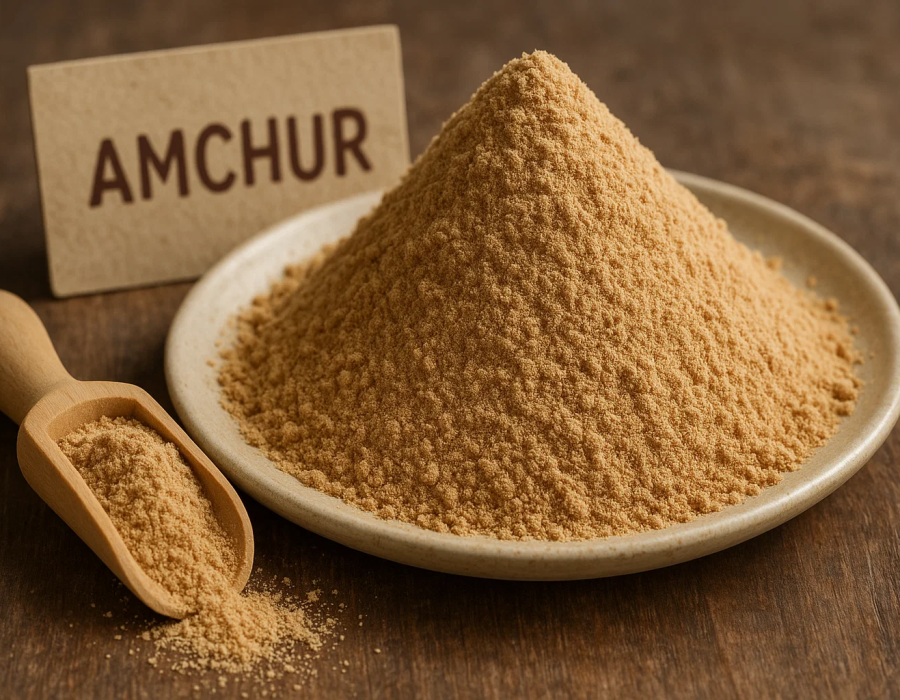If you’ve ever bitten into a dish that had a tangy kick without a hint of lemon or vinegar, chances are you’ve tasted amchur. This magical spice has been quietly elevating Indian dishes for centuries. But what exactly is it, and why is it so important that many home cooks say their kitchen feels incomplete without it? Let’s dig in.
What Exactly Is Amchur?
- Amchur (sometimes spelled amchoor) is dried unripe mango powder.
- The name itself comes from two Hindi words: aam (mango) and chur (powder).
- It’s light brown to beige in color, fine in texture, and instantly recognizable for its tart, citrusy punch.
In short: amchur is the flavor of raw mango preserved for year-round use.
The Origins: From Mango Orchards to Spice Boxes
India has always been the land of mangoes, with over a thousand varieties growing across the country. But mango season is short. Hundreds of years ago, cooks and spice traders found a way to make the taste of sour, green mango available even after the season ended—by drying and grinding it.
- Geography: Amchur is most commonly linked to North Indian cuisine, especially Uttar Pradesh and Rajasthan.
- Tradition: In arid regions like Rajasthan, where fresh produce was limited, dried spices like amchur became lifesavers.
- Trade: Over time, amchur made its way into markets, spice blends, and eventually global Indian restaurants.
Think of it as a culinary hack from the past that became timeless.
What Makes Amchur Irreplaceable?
Why not just use lemon juice, tamarind, or vinegar for tang? The answer lies in amchur’s unique character.
Amchur delivers a controlled tang with a fruity undertone. It brightens food without making it watery or overpowering. That’s why traditional recipes don’t substitute it—they just wouldn’t taste the same.
Everyday Uses of Amchur
Here’s how amchur shows up in Indian kitchens:
- Curries & Gravies: Adds depth to lentils (dal), chickpea curry (chole), and vegetable dishes.
- Dry Sabzis (Veggies): A pinch transforms simple potatoes or okra into something lively.
- Chaats & Street Food: Essential in spice blends like chaat masala, giving snacks their signature tang.
- Marinades: Tenderizes meat and paneer while adding a zesty layer.
- Pickles: Used alongside mustard seeds and chili to balance flavors.
👉 Quick example: Imagine aloo gobi (potato-cauliflower curry) without that tart lift—it would feel flat. Just a teaspoon of amchur changes everything.
Beyond India: Amchur’s Modern Appeal
What’s interesting is how amchur is now stepping out of traditional boundaries:
- Fusion Cooking: Chefs are using it in salad dressings, barbecue rubs, and even cocktails for a mango-tang twist.
- Health Conscious Diets: Since it adds acidity without extra liquid or calories, it’s popular among those reducing salt or sugar.
- Global Pantries: With Indian spices becoming mainstream, amchur is appearing in kitchens from New York to London.
Fresh perspective: Amchur is like lemon zest’s Indian cousin—subtle, fragrant, and transformative.
Health Benefits of Amchur
Traditional Indian households don’t just value taste; spices are often tied to nutrients. Amchur carries several benefits:
- Rich in vitamin C (boosts immunity).
- Helps in digestion due to its acidic nature.
- Acts as a natural preservative in food.
- Considered useful for weight management, as it enhances flavor without extra fat.
How to Use Amchur in Your Cooking?
- Start small: about ½ to 1 teaspoon per dish is enough.
- Always add it toward the end of cooking to preserve its tang.
- Store in an airtight jar in a cool, dry place—it keeps well for months.
Chukde Amchur Powder
If you’re wondering what to buy, Chukde Amchur is a reliable choice. Here’s why:
- Sourced from quality raw mangoes, ensuring finest tang.
- Clean and natural—free from fillers or unnecessary additives.
- Comes in sealed packs to lock in freshness.
Many home cooks trust Chukde for consistent flavor. It’s the kind of pantry staple that can instantly upgrade your cooking.
FAQs About Amchur
1. Can I skip amchur in a recipe?
Technically yes, but the dish will lose its signature tang. Substitutes like lemon or tamarind won’t replicate the exact flavor.
2. Is amchur spicy?
No. It’s tangy and fruity, not hot.
3. Can I make amchur at home?
Yes, by drying raw mango slices in the sun and grinding them. But it’s time-consuming, which is why store-bought brands like Chukde are practical.
4. Does amchur expire?
Like most spices, it doesn’t go “bad,” but the flavor fades after 6–8 months if not stored properly.
5. Is amchur used outside Indian food?
Yes. Creative cooks use it in salad dressings, soups, and even roasted nuts.
Final Thoughts
Amchur is more than just a spice—it’s heritage in a jar. It bridges seasons, adds character, and keeps recipes true to their roots. From street food to family curries, amchur’s role in Indian cuisine is irreplaceable.
So, the next time you want your dish to pop with that signature tang, skip the lemon and reach for amchur. If you want guaranteed quality, Chukde Amchur is a brand worth keeping on your shelf.






Comments